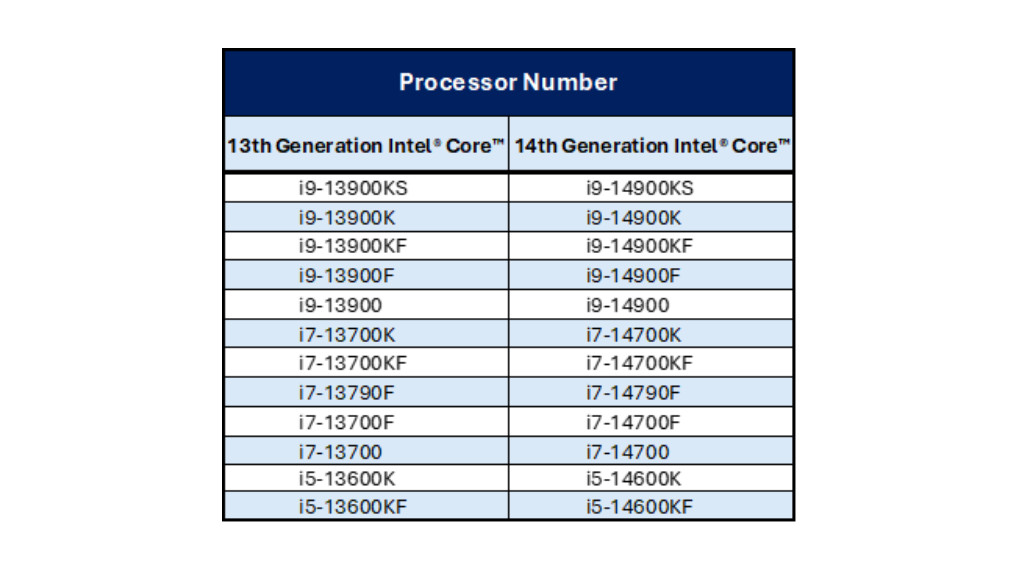Intel calms fears over some 13th-gen or 14th-gen buyers missing out on extended warranty for instability issues – now all CPUs are covered, but worries remain
Extended warranty gives all these CPUs five years of coverage – including chips in prebuilt PCs

Intel has decided that the warranty extension the firm announced last week, for chips affected by instability issues, applies to all its 13th-gen and 14th-gen processors, and not just boxed CPUs.
If you recall, when the move, which upped the warranty from three to five years, was made, Intel said it applied to boxed products, but not CPUs that came in prebuilt PCs. (So-called ‘tray’ CPUs, named because they’re supplied in volume, in trays, to PC makers, with no box or packaging – as this isn’t needed, and is an unnecessary cost in this case).
As VideoCardz spotted, Intel has supplied some further details on the warranty extension, and in the title of that post (from Thomas Hannaford, Intel’s Communications Manager), there’s a key new nugget – that the warranty applies to “Intel Core 13th/14th-gen Desktop Boxed/Tray CPUs.”
So, note the mention now of both boxed and tray processors, whereas before, Intel had said that there was “two-year extended warranty support for our boxed Intel Core 13th and 14th-gen desktop processors.” (Our bolding for emphasis in both cases).
Team Blue also lists all the chips from these generations that are covered by the warranty extension, as you can see in the screenshot below (from the Core i5 13600K/14600K and upwards, basically – but not the non-K versions of the 13600/14600, it should be noted).

Analysis: Bad timing
Intel is busy firefighting a pretty nasty PR disaster at this point, which is likely why this warranty coverage has been broadened. At any rate, it’s good to get an official acknowledgment that whatever 13th-gen or 14th-gen chip you have, if it’s an affected model as listed in the above table, you get the benefit of that five-year warranty – whether the processor was bought separately in a box, or it came in a prebuilt PC.
There’s still a good deal of discontent rumbling and echoing around various online forums regarding this whole issue. For starters, there’s the topic of when the microcode update – the preventative patch that’s inbound – is going to arrive. We were promised it for mid-August, and that’s only about a week away now, yet there’s still no word.
Sign up for breaking news, reviews, opinion, top tech deals, and more.
Granted, it could still be right on track, but we’re getting close now. And to be fair, we’d rather Intel took the time to get this as right as possible, as opposed to rushing out the update – so there’s that too.
However, there are also concerns for those affected who’ve returned their CPU, and might be getting a new replacement chip soon – if it arrives before said microcode patch, is it safe to install the processor and run it (or might that damage it, if the preventative update isn’t ready and released)? Or will new chips come with this microcode tweaking already baked in? We don’t know.

As far as we’re aware, Intel is still investigating these stability problems to see if further key causes might be lurking under the hood of Raptor Lake and Raptor Lake Refresh processors. There’s a sense of unease and uncertainty about Intel’s overall approach here, and for us, the concern that perhaps processors that seem unaffected right now, might eventually manifest glitches well down the line. (Which is doubtless what the warranty extension is about – but what about CPUs past that five-year point)?
We’re also waiting for Intel to pin down the separate oxidation issue with more accuracy (in terms of providing batch numbers of affected processors), and some folks online are still worried about 13th-gen or 14th-gen laptop chips too, even though Intel has assured us these are not affected.
With Arrow Lake CPUs due later this year, and Ryzen 9000 releasing imminently, Intel faces an uphill struggle on the desktop already – without these further doubts being cast on its existing desktop CPU ranges.
Laptop processor worries won’t help either, even if they are unwarranted. Especially as Intel is facing off two foes on this front, given the hype around new Copilot+ PCs – namely Qualcomm’s Snapdragon X silicon, and Ryzen AI 300 mobile processors.
In short, it’s a bad time for all this to be happening, and we feel Intel needs to step up the damage control over these stability gremlins, and deliver some further clarifications as soon as possible.
You might also like
Darren is a freelancer writing news and features for TechRadar (and occasionally T3) across a broad range of computing topics including CPUs, GPUs, various other hardware, VPNs, antivirus and more. He has written about tech for the best part of three decades, and writes books in his spare time (his debut novel - 'I Know What You Did Last Supper' - was published by Hachette UK in 2013).